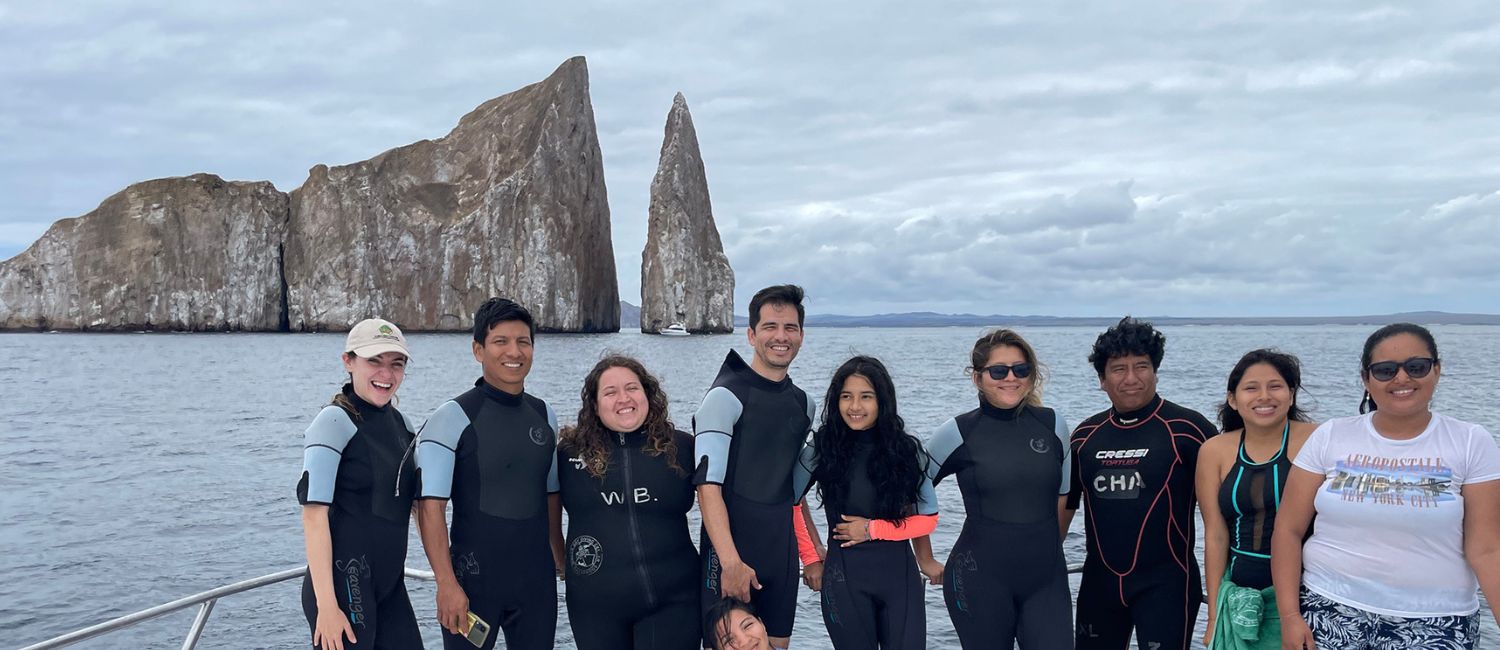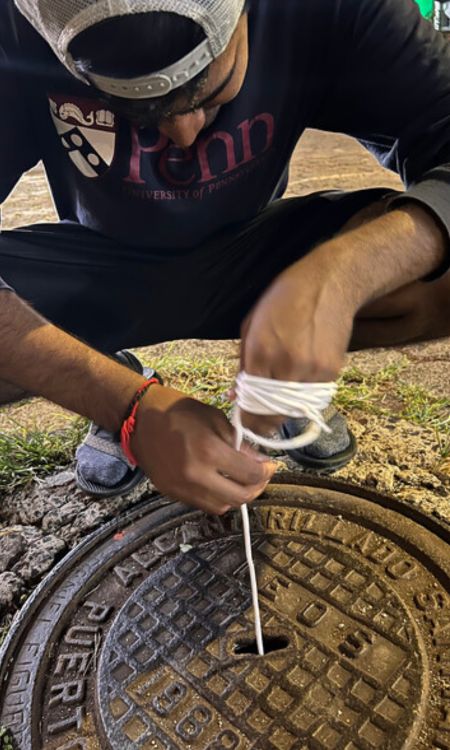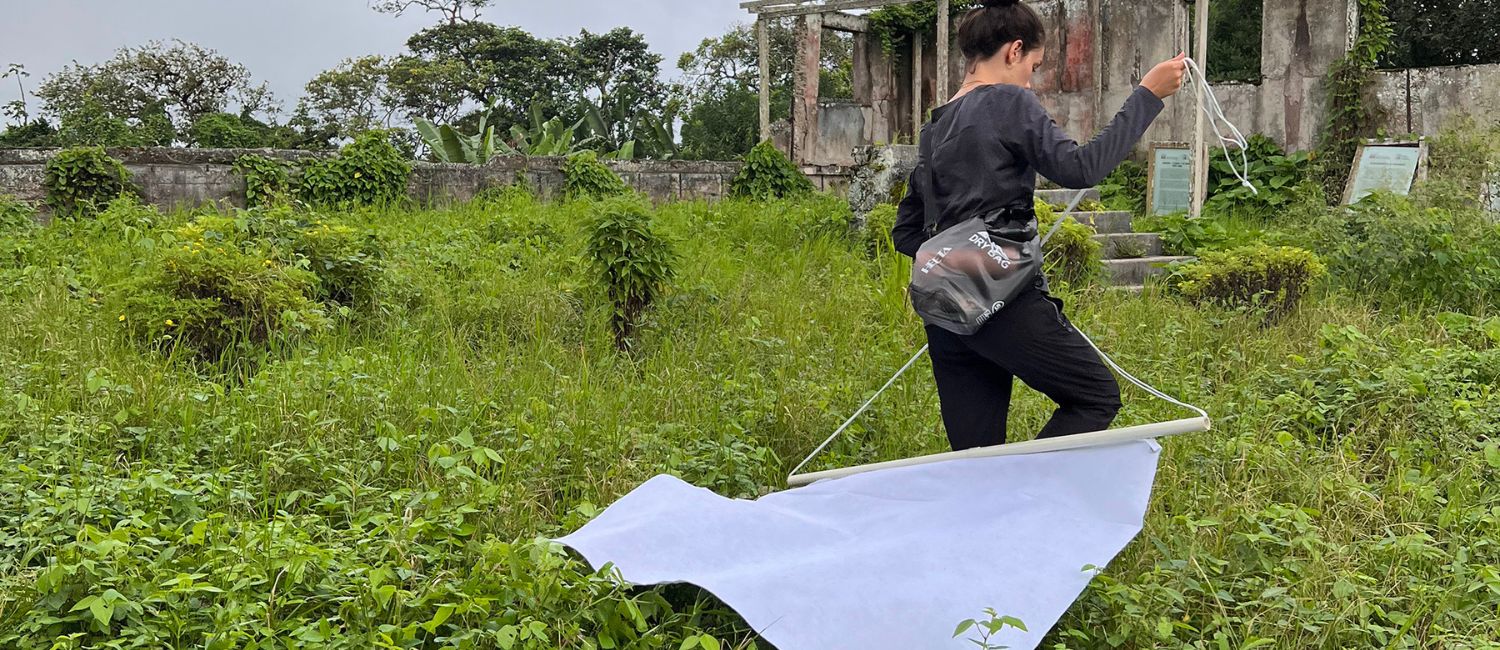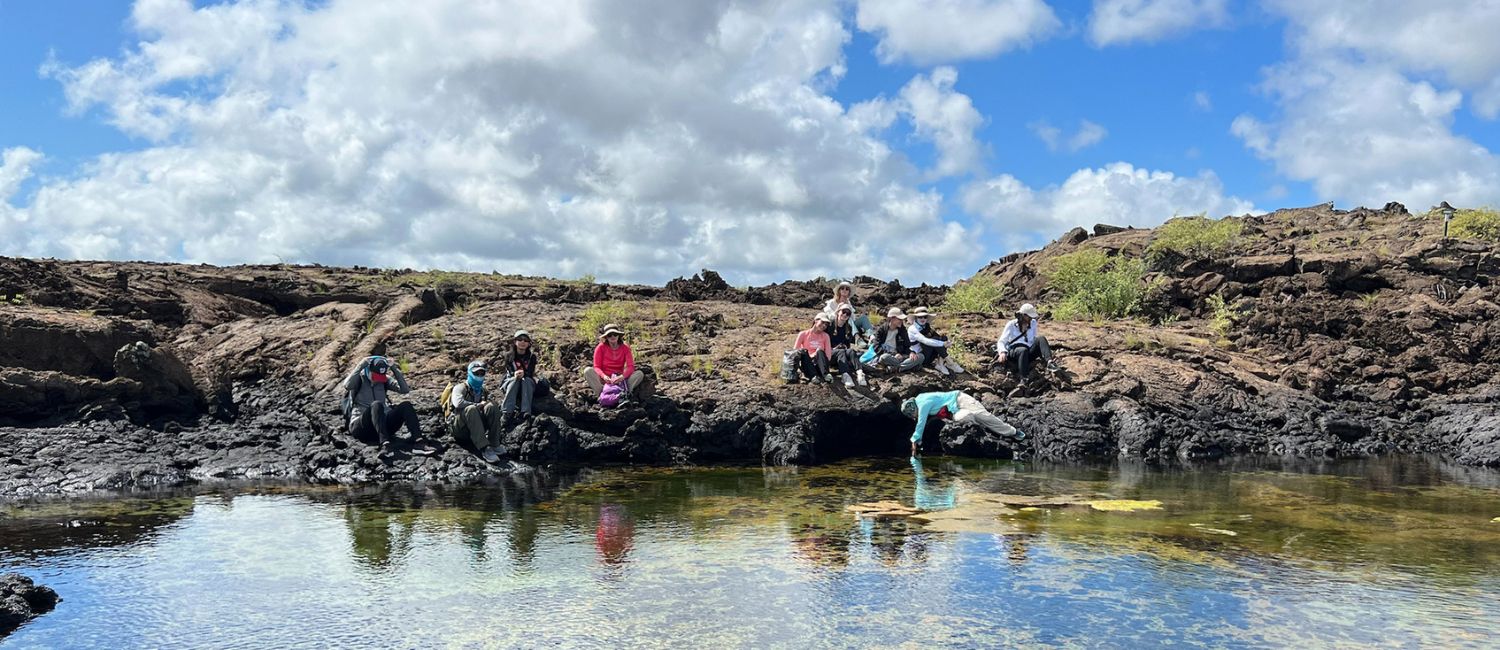 Local community scientists were thanked for their contributions with a snorkeling outing to Leon Dormido, a rock formation off the coast of San Cristóbal Island in the Galápagos, with coordinators Kelly Kennedy (left) and Wilson Castillo (center). (Image: Courtesy of Kelly Kennedy)
Local community scientists were thanked for their contributions with a snorkeling outing to Leon Dormido, a rock formation off the coast of San Cristóbal Island in the Galápagos, with coordinators Kelly Kennedy (left) and Wilson Castillo (center). (Image: Courtesy of Kelly Kennedy)
Daniel Beiting, PhD, associate director of the Institute for Infectious and Zoonotic Diseases, expanded his work this summer in the Galápagos, giving Stephanie Sila, V’25, an ideal opportunity to gain first-hand experience in identifying different mosquito species and human disease cases on the island.
Undergraduate and graduate students spent two months on San Cristóbal Island this summer, doing research on antibacterial resistance, vectors of disease, climate change adaptation, and the impact of climate change on mental health.
On a June morning on San Cristóbal Island in the Galápagos, Naomi Phemister-Jimenez and Katie Gilbert might eat bolón de verde—green plantain fritters—for breakfast with their host family before picking up supplies to collect and test water samples. Their schedule of places to visit that day could include popular swimming spots, remote beaches, or run-off pools from local farms.
In a makeshift lab, Phemister-Jimenez and Gilbert—both fourth-year students majoring in biology and minoring in Spanish—pipette samples onto thin paper cards, which act as portable petri dishes to grow bacteria present in the water samples. They later test whether these bacteria are resistant to a range of antibiotics.
Throughout the summer, they received mentoring from recent College of Arts and Sciences graduate Arnav Lal, who was in the Galápagos last summer and knows the site locations. They also taught sixth-graders about the scientific method, growing and counting bacteria from ocean water, and vectors of disease. They helped School of Veterinary Medicine student Stephanie Sila catch mosquitos and ticks, for a different project. And they snorkeled in an area called Tijeretas, swimming with marine iguanas and blowing bubbles with sea lions.
These students were among seven people from Penn who spent two months in the Galápagos this summer, along with fourth-year environmental studies major Lía Enríquez, Master of Public Health student Vanessa Pacheco, and Kelly Kennedy, lab manager for the Galápagos Education and Research Alliance (GERA).
“Seeing everything to do there and learning from everyone there, I feel like my science skills got a lot better, I feel like my Spanish skills got a lot better, and it was incredible to just push myself outside my comfort zone,” says Gilbert, who is from Ellicott City, Maryland.
While GERA research pre-pandemic centered on the relationship between sea lions and human residents, students this summer focused on antibacterial resistance, vectors of disease, climate change adaptation, and the impact of climate change on mental health.
“We call our research approach ‘social ecology,’” says Michael Weisberg, director of GERA and chair of the Philosophy Department in the School of Arts & Sciences, “and the idea is to really think about the whole system: human, non-human, and the abiotic environment. In Galápagos, it’s very easy to ignore the human part of the system since the wilderness areas are very well-preserved, but we think this is a mistake. If we miss the human dimensions, we won’t really understand the place.”
This was the fifth summer since 2017 Penn students went to the Galápagos and the second through Penn Global Research Institutes (PGRI). Lab manager Kelly Kennedy, who went to the Galápagos as a fourth-year Penn student in 2017, says that her time in the Peace Corps after getting her bachelor’s degree taught her to apply a pre-departure model that involves more cultural understanding, historical and political context, and language exposure. Similarly, PGRI students begin pre-departure preparation in January, go to the Galápagos in the summer, and do data analysis and follow-up work until December.
Ecuador established Galápagos National Park in 1959, designating 97% of the islands’ land area as national park and 3% for people to live. Despite a population increase from around 2,000 to more than 40,000, plus a boom in eco-tourism, residents still have the same 3%.
“People sometimes talk about the ‘Galápagos paradox,’ which is that people are coming to see something that they destroyed by coming, and people live there for a reason that their living there destroys,” Weisberg says.
‘One Health’
The Galápagos health projects revolve around the “One Health” approach, which Daniel Beiting of the Vet School says is the idea that public health is “more than just human health; it has to consider animal health and health of the environment.” Beiting, associate director of the Institute for Infectious and Zoonotic Diseases, has long worked on diseases that move between animals and people, and he got involved with GERA a few years ago.
 Arnav Lal collects a sewage sample in downtown Puerto Baquerizo Moreno on San Cristóbal Island. (Image: Courtesy of Lisa Mattei)
Arnav Lal collects a sewage sample in downtown Puerto Baquerizo Moreno on San Cristóbal Island. (Image: Courtesy of Lisa Mattei)
Last year, advised by Beiting and senior researcher Lisa Mattei, Lal sequenced DNA from marine organisms, pathogens, and bacteria in contaminated beach water from four sites. At a site where locals said sewage was entering the water, Lal found that bacteria carried multiple genes that suggest resistance to antibiotics.
Lal says it was exciting to conduct fieldwork in a remote place he has read about for years, and that it was interesting to come back this summer and see the evolution of the project. He continued the sequencing work, and he also teamed up with Phemister-Jimenez and Gilbert to validate the genomic sequencing data by collecting water samples at both the previous sites and new ones, isolating bacteria from the water, and testing for sensitivity to a broad range of antibiotics.
“One of the major successes and things I found so fascinating about the work we did, beyond the antibiotic resistance itself, is the fact we were able to do it on a remote island without a lab,” says Phemister-Jimenez, who is from Newburgh, New York. “We had mini, portable versions of every machine that we needed, so that included a qPCR machine, a regular PCR machine, an incubator, and a gel electrophoresis machine.”
Weisberg says they at least had a converted office to use as a makeshift lab this year, whereas last year’s setup was “a dining room table next to the pasta maker at our friend’s house.”
A research project on wildlife medicine
Beiting also wanted to involve a veterinary student for the first time this year, which led to his second project. Recognizing the complexities and challenges of “putting hands on animals” in a protected national park, he opted to focus on ticks and other vectors of disease, such as mosquitoes and black flies.
It was not clear to him at first whether there was a large mosquito population or what species of tick existed on the island. Mattei went to San Cristóbal Island in March ahead of students’ arrival, because “it would be awful if they looked for ticks all summer and didn’t find anything,” she says. Mattei says the distribution of Asian blue ticks, brown dog ticks, and tropical horse ticks—and whether they carry pathogens—is unknown.
“To make sure the students would have a viable summer project, we did tick dragging and flagging in different places around the island, and also met with a local cattle farmer,” she says. “We found tick larvae in the vegetation around El Progreso, a rural community at the entrance to the highlands. We also found a tick in the ear of a stray dog in that same neighborhood. The cattle farmer showed us some of his cows and they were sadly covered in hundreds of ticks.”
 Naomi Phemister-Jimenez collects ticks—by a method called tick dragging—in the community of El Progreso. (Image: Courtesy of Lisa Mattei)
Naomi Phemister-Jimenez collects ticks—by a method called tick dragging—in the community of El Progreso. (Image: Courtesy of Lisa Mattei)
Penn Vet student Stephanie Sila says she worked with local veterinarians and the vector control agent, learning how to identify different mosquito species and about human disease cases on the island. Sila says this work directly aligned with her interests in wildlife medicine and infectious/zoonotic diseases, “and gave me more insight on the process of piloting projects and building research connections.”
Sila collected mosquitoes and ticks directly from animals, storing them to get DNA samples later and test for pathogens. Beiting explains that researchers can identify the animal on which a tick was feeding by the protein in the tick’s blood, making the vectors an effective surrogate for studying animal health on San Cristóbal Island.
He says the forthcoming analysis on both projects, meaning further study of antibiotic resistance and tick distribution on the island, will drive what students do next summer. If researchers find prevalent resistance to certain antibiotics, a next step could be examining antibiotic use for both humans and farm animals on the islands.
Doing community work right
This was the second year in San Cristóbal for Enríquez, who is from mainland Ecuador. She says everything about the island feels familiar: the expressions people use, the frequency of eating plantain-based dishes, the value placed on sitting down for a meal together. Enríquez—who stayed with the same host family as Phemister-Jimenez, Gilbert, and Lal—spent the past two summers talking to community members about climate adaptation.
She often worked with Wilson Castillo, a pastor who is GERA’s local project coordinator, who connected her both to locals to interview and other community members to do the interviewing—community scientists. “The goal of the whole project was to get people in the community involved in every single step of the scientific process,” Enríquez says. They helped identify the right questions to ask, and she then trained them on the protocol for asking questions.
Enríquez would settle into people’s living rooms to ask about the effects of the last heavy rainfall event or hot season they remembered, such as whether streets were accessible or they experienced any health issues, and about their desired interventions.
She explains that because of the steep incline from the highlands down to the town of Puerto Baquerizo Moreno, the dirt roads that cross freshwater outlets get washed out with frequent rain. Enríquez also heard worries from community members about a lack of trees and an absence of air conditioning.
Next steps, Kennedy says, will be coding interviews, discussing solutions, and coming up with ways to communicate results to the community. Weisberg says the “theory of the project is to go from risks to plans,” and he hopes to engage Penn students and faculty from planning or landscape architecture.
Enríquez also helped Vanessa Pacheco with her project on climate change and mental health. The MPH student carried on the work MD-MPH student Victoria Moffitt did last year assessing children’s climate anxiety in the Galápagos, and Pacheco’s role this summer was to implement an educational piece.
Pacheco did this by teaching lessons to middle- and high-school-aged scouts on the island, who she says are very passionate about the sea lions and sea turtles they see every day. “Victoria had asked children to draw what they thought the island would look like in a hundred years, and a lot of them drew different aspects of the animals dying,” Pacheco says. To empower students, Pacheco framed lessons around what could be done on the island or at a policy level to protect species.
Pacheco has a passion for health disparities and social determinants of health, and has always been interested in Hispanic health. With a plan to go to medical school, Pacheco says the Galápagos experience was something she needed to get to “really open my perspective globally to different communities, different cultures. Even though I am Ecuadorian, the Galapagueño culture is something on its own. And I think it's very important that I got to see that and be a part of it.”
 On a Penn Global Research Institutes outing to Tortuga Bay, students and Penn Global’s Laurie Jensen sit on rocks in a lava field overlooking a hypersaline pool. (Image: Michael Weisberg)
On a Penn Global Research Institutes outing to Tortuga Bay, students and Penn Global’s Laurie Jensen sit on rocks in a lava field overlooking a hypersaline pool. (Image: Michael Weisberg)